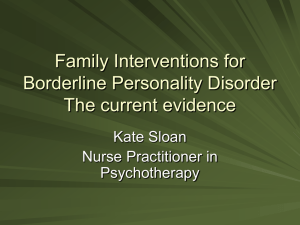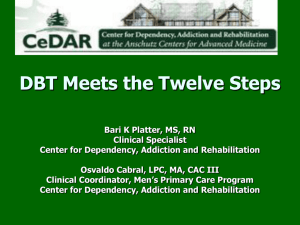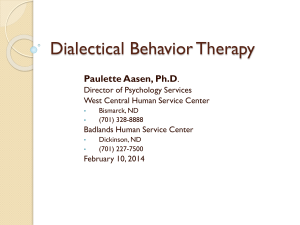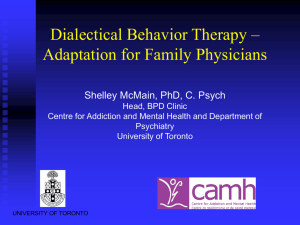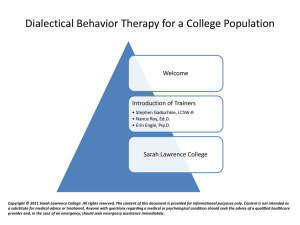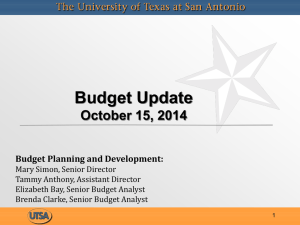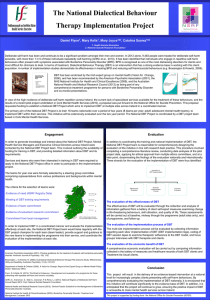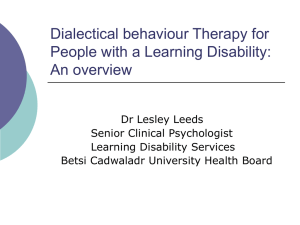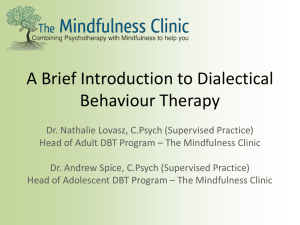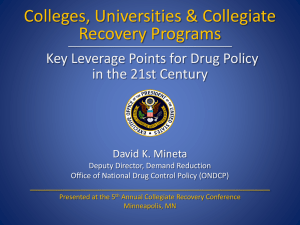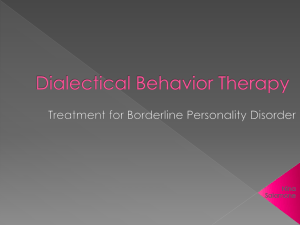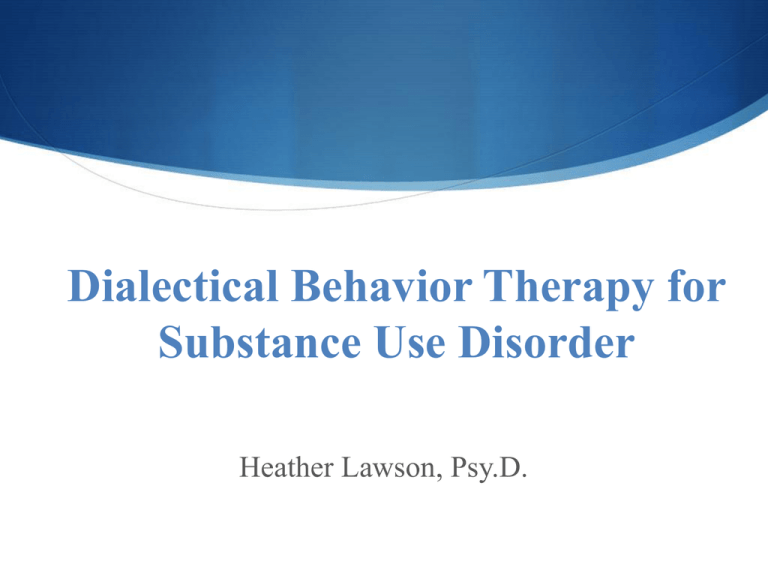
Dialectical Behavior Therapy for
Substance Use Disorder
Heather Lawson, Psy.D.
Training Goals
• Review essential characteristics of dialectical behavioral
therapy (DBT).
• Review recent empirical research of DBT with borderline
personality disorder (BPD) and substance use disorder (SUD).
• Learn principles to determine the appropriateness of DBT for
persons with SUD.
• Review adaptations of DBT for SUD, including development of
new skills for SUD individuals.
What is DBT?
• A structured, time-limited, cognitive-behavioral treatment
(CBT) developed by Dr. Marsha Linehan in early 90’s.
• Primary difference between DBT and other CBT treatments is
its focus on Mindfulness.
• Efficacy for decreasing symptoms of BPD has been
demonstrated in randomized controlled trial (RCT) studies.
• Research on DBT for SUD shows positive results in two RCT’s
(1999, 2002).
DBT in a Nutshell
• Acceptance and Change Dialectic: DBT relies on frame of
acceptance (validation) and need to change dialectic to help
patients learn skills to change their lives.
•
Ex: “Using substances works for you in the short-term to get rid of
negative emotions, but it is exceedingly unlikely that you will be able to
achieve your long-term goals if you continue using.”
• Change-Based Strategies: Skills training, behavioral analysis,
exposure, contingency management
Modalities of Treatment
1. Individual psychotherapy
2. Skills group
Core Mindfulness
Distress Tolerance
Emotion Regulation Interpersonal Effectiveness
3. Phone coaching
4. Consultation team
Skills
• Core Mindfulness: Teaches patients how to focus attention so they
can participate in life with awareness.
• Distress Tolerance: Includes skills for tolerating painful situations
without doing something to make things worse.
• Emotion Regulation: Teaches a model for understanding one’s own
emotions and skills to regulate them.
• Interpersonal Effectiveness: Teaches patients how to identify
objectives in relational situations and use skills to meet objectives.
DBT: Structure of Treatment and
Targets
Patients we work with have so many problems. DBT has a
clear structure related to where to start with treatment
targets.
1.Suicidal and self-harmful behaviors
2.Reduce treatment interfering behaviors
3.Reduce quality-of-life interfering behaviors: including
substance use
4.Increasing skills to manage life
Why DBT for SUD?
•
Studies show significant overlap of BPD and SUD
Linehan, 2010
•
BPD and SUD = troublesome combination
•
Severe psychopathology upon hospital admissions predicts poorer outcome
and early relapse among drug abusers
Saxon and Calsyn, 1995; McLellan, et al., 1992, 1983; Woody, et al., 1985
•
Substance abuse is risk factor for suicide attempts
NIMH, 2010
Research on DBT/SUD to date
2 Randomized Controlled Trials
• DBT vs. Treatment as Usual (TAU)
University of Washington: Linehan, Schmidt, Kanter, Craft, et al., 1999
• DBT vs. Comprehensive Validation Therapy (CVT) with 12-Step
University of Washington: Linehan, Dimeff, Reynolds, Comtois, et al., 2002
DBT vs. TAU with BPD/SUD
DBT > TAU
•
•
•
•
•
Drug use
Dropout
Global and social adjustment
Treatment retention
DBT gains continued at 16-month follow-up
Linehan, Schmidt, Kanter, Craft, et al., 1999; University of Washington
DBT vs. CVT + 12-Step
with BPD/SUD
• Not significant; everyone got better
• Drug use
• Global and Social Adjustment
• CVT + 12 Step > DBT
• Treatment retention
Linehan, Dimeff, Reynolds, Comtois, et al., 2002; University of Washington
Summary of Research Findings
• Studies suggest that using DBT to treat individuals with
BPD and SUD is effective in reducing substance use.
• DBT excels in addressing other problems substance-using
individuals have.
• Studies still needed to substantiate efficacy of using
recently-developed adaptations of DBT for duallydiagnosed patients.
DBT for BPD with SUD
•
Essentially same treatment with slightly different emphasis on:
• Picking targets
• Skills modifications and development of new skills for SUD patients
• Attachment strategies for difficult-to-engage patients
•
Targets adapted for BPD with SUD
• Substance use (Goal is Abstinence + Functionality)
• Lying
• Teaching dialectic of emotional vulnerability and self-invalidation
• Building a life living (overarching goal of DBT)
Case to Illustrate Application of
DBT for BPD with SUD
• 25-year-old, single, Caucasian female
• Diagnosed with MDD, Recurrent, In Full Remission, BPD,
Alcohol and Cocaine Abuse.
• Frequency of cocaine use typically 3x/weekly.
• Alcohol use on average: 5x/weekly, 1-5 glasses of wine.
DBT Has Many Ways to Separate
People from Addiction
One way is through this doorway of
understanding the dialectic of emotional
vulnerability and self-invalidation.
What is Emotional Vulnerability?
• Heightened sensitivity
• Increased intensity
• Slow return to baseline
What is Self-Invalidation?
Self-invalidation: Non-acceptance of one’s thoughts, feelings,
and behaviors
• “I shouldn’t be this way.”
• “I’m flawed.”
• “I’m broken.”
• “I’m an addict.”
Oversimplifying substance abuse problem:
• “I’ll never do this again.”
• “I can be perfect today.”
Dialectic of Emotional Vulnerability and
Self-Invalidation in Treatment
• DBT has transparency. Provide psychoeducation and share
dialectical poles with patients:
•
"You’re stricken with intense sadness when the guy you like at work
doesn’t say hello to you (emotional vulnerability). Then, you judge
your emotional reaction (self-invalidation) causing feelings of shame.”
•
“The combination of emotional vulnerability and self-invalidation
increases urges and likelihood of substance use.”
•
“Skills to regulate emotions and validate yourself will help decrease
the likelihood of that you will use.”
Rationale for Abstinence Goal for
BPD with SUD
• The difficulties experienced by BPD patients with SUD make
it exceeding difficult for them to use in moderation.
• Focusing on abstinence, as opposed to harm reduction,
increases the length of time to use.
• Encourages re-conceptualization of identity that’s helpful to
achieve goal of sobriety.
Linehan, 2010
Dialectical Abstinence Model
• DBT expects abstinence as a goal, yet recognizes patients lack skills to stay
sober and build a life worth living without substance use.
• DBT teaches strategies for abstinence and harm reduction = dialectical
abstinence.
• Patients with emotion dysregulation and self-invalidation are prone to
Abstinence Violation Effect (huge risks for “oh, screw it” factor).
• Large risk that relapse can be lethal due to body physiology changes.
• Message: Have to be abstinent and have to be careful how to get there.
Metaphor of DBT Synthesis of
Dialectical Abstinence
• “If you get one flat tire, you don’t get out of the car
and let all the air out of all your tires.”
• Find your own personal stories to develop
metaphors bring concepts to life for patients.
Strategies for Abstinence
• Burn bridges with dealers/users
• Planning other activities to do instead of using
• Spending time with people who will reinforce not using
• Remind self of reasons to stay abstinent
• Public announcement of quitting
• Avoiding cues (identification of cues and use of worksheet)
• Using skills
Strategies for Harm Reduction
•
•
•
•
•
•
•
•
Phone coaching (similar to AA’s use of sponsor)
Remind self why being on drugs is harmful
Contact clean people
Get rid of substances so can’t use more than already have
Cheerleading: “I can climb back on the wagon.” “One slip is not a
disaster.”
Do a chain analysis
Use pros/cons skill of stopping now
Turn the mind away from extreme thinking and look for the middle
ground
Use of Dialectical Abstinence in
Session
“You’ve tried to control your use of alcohol and cocaine for
years and haven’t been able to. Your frequency of use has
increased and worsened your depression. I understand how
it’s hard to quit when all of your friends use. However, it’s
unlikely things will get better for you unless you stop. I’m
going to teach you set of strategies to get and stay clean, as
well as skills to get you back on track in case you slip.”
Use of Diary Cards to Reduce
Substance Use
• Patients are instructed to complete diary cards each day.
• If don’t do, asked to do in session (use of negative
reinforcement).
• Diary cards are reviewed beginning of session with targets kept
in mind.
• Do chain analysis for targets/problem behaviors.
• Get commitment.
• Practice skill in office to reduce target or problem behavior.
• Troubleshoot what would get in the way of skills working.
Case Example: Use of Diary Card
for Substance Use
• Patient did not do diary card, so asked her to do
retrospectively.
• Verbalized observations:
“Sunday through Tuesday were great days, you used a lot of
skills and felt pretty good. You drank and looked for cocaine
on Wednesday and had unprotected sex with guy you didn’t
know that you later regretted. You drank alone on Thursday
and searched for coke...”
Case Example: Use of Diary Card
for Substance Use
• Decide on recent episode in which target behavior
occurred to review in session.
• “Let’s go over your most recent incident of substance use and
unprotected sex and see if we can figure out where you could
have done something differently.”
• Asked patient if there was something in addition to our BA
she wanted to talk about for relationship building and
reinforcing in session trouble-shooting behavior.
Use of Behavioral Analysis for
Substance Use
1. Figure out problem.
2. Conduct behavioral analysis (BA): vulnerabilities,
precipitating event, interpretations, antecedents,
links, consequences.
3. Analyze chain of events and figure out where
train came off tracks.
4. Generate solutions and new behaviors.
Case Example: Use of BA
Vulnerability Factors
• Holiday period (1/1/11)
• Recent exposure to family
• Sleep deprivation
• Recent blow-up with roommate
Case Example: Use of BA
Precipitating Events, Antecedents, Links
➥ Disappointed in morning when a guy she is interested in
doesn’t get back to her,
➥ Later upset that a guy she likes at work doesn’t interact
with her during her shift,
➥ Has downward comparison thoughts,
Case Example: Use of BA
Precipitating Events, Antecedents, Links (continued)
➥ Experiences intense emotion dysregulation,
➥ Passes bar on way to train,
➥ Decides to drink to alleviate emotional pain,
➥ Meets guy at bar and under influence, goes home with
him, does cocaine and has unprotected sex with him.
Case Example: Use of BA
Consequences
• While she alleviates emotional pain in short-term, the next day
she experiences self-disgust, regret about wasting money when
she doesn’t even have money for rent, and significant
depression.
Pros/Cons
• Patient identifies pros/cons of substance use and pros/cons of
not using.
Case Example: Use of BA
Solution Analysis
• Self-validation related to holidays being hard time.
• Unmindfulness of upsetting thoughts.
• Focusing attention instead on upcoming positive things and
“mastery” experiences to replace harmful thoughts.
• Pros/Cons thinking before entering bar.
• Not walking on street where bar she likes is located.
• Observe urge and “surf it.”
• Call/text therapist.
Skills Developed for patients with
SUD
Burning bridges; options for decent life:
• Delete phone numbers, tell people you’re quitting, join sober
activities.
Urge surfing: Use of imagery to tolerate urges without acting on
them.
Adaptive denial: Let go of identifying self as addict.
Alternate rebellion: Finding alternative ways to be counterculture,
and to satisfy thrill associated with the “chase” involved in
substance use.
Skills Developed for patients with
SUD
Avoid and eliminate cues for substance use:
• Mindfulness
• Change numbers
• Get rid of paraphernalia
• Move
TIP (Temperature/Intense Exercise/Progressive Muscle
Relaxation)
• Involves use of physiology to regulate emotions.
• Ex: Submerging face into ice water and holding breath, eliciting
“dive response” — this has been found to help regulate emotions.
DBT for SUD: Focus on Urges
• Psychoeducation about urges (normalization of urges,
episodic nature of them, fluctuate in intensity, giving into
them reinforces them).
• Have patients mindfully monitor urges on
diary cards.
• Techniques to resist acting on urges
(mindfulness, pros/cons thinking, imagery,
e.g., Samurai chopping head of urge
with a saber).
Attachment Strategies
• Identify this as potential problem at first session.
• Asks patients where to find them should they disappear.
• Increase contact with patient in first few months in effort
to get patients to connect (text, email, call).
• Speak to team to avoid burn-out
and try to think of as a puzzle
and challenge instead of
annoying patient.
When to Refer?
• BPD with SUD
• Non-BPD with SUD with many complicating problems
• E.g., emotion regulation, behavioral dysregulation,
relationship problems, impulsivity, suicidal and self-harmful
behaviors
• Multiple Axis I and Axis II problems
• Non-BPD with SUD for whom other treatments haven’t
worked
Thank You
Questions or comments?
Heather Lawson, Psy.D.
drheatherlawson@gmail.com

